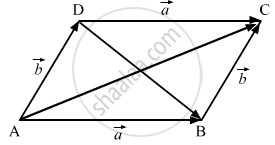Advertisements
Advertisements
प्रश्न
If \[\vec{a}\] and \[\vec{b}\] are two non-collinear vectors having the same initial point. What are the vectors represented by \[\vec{a}\] + \[\vec{b}\] and \[\vec{a}\] − \[\vec{b}\].
उत्तर

Given: \[\vec{a} , \vec{b}\] are two non-collinear vectors having same initial points. Complete the parallelogram \[ABCD\] such that \[\overrightarrow{AB} = \vec{a}\] and \[\overrightarrow{BC} = \vec{b} .\]
In \[\bigtriangleup ABC\]
\[\overrightarrow{AB} + \overrightarrow{BC} = \overrightarrow{AC} \]
\[ \Rightarrow \vec{a} + \vec{b} = \overrightarrow{AC}\]
In \[\bigtriangleup ABD\]
\[\overrightarrow{AD} + \overrightarrow{DB} = \overrightarrow{AB} \]
\[ \Rightarrow \vec{b} + \overrightarrow{DB} = \vec{a} \]
\[ \Rightarrow \overrightarrow{DB} = \vec{a} - \vec{b}\]
Therefore,
APPEARS IN
संबंधित प्रश्न
Classify the following measures as scalars and vectors:
(i) 15 kg
(ii) 20 kg weight
(iii) 45°
(iv) 10 meters south-east
(v) 50 m/sec2
Classify the following as scalars and vector quantities:
(i) Time period
(ii) Distance
(iii) displacement
(iv) Force
(v) Work
(vi) Velocity
(vii) Acceleration
Answer the following as true or false:
Two collinear vectors are always equal in magnitude.
If \[\vec{a}\] is a vector and m is a scalar such that m \[\vec{a}\] = \[\vec{0}\], then what are the alternatives for m and \[\vec{a}\] ?
Five forces \[\overrightarrow{AB,} \overrightarrow { AC,} \overrightarrow{ AD,}\overrightarrow{AE}\] and \[\overrightarrow{AF}\] act at the vertex of a regular hexagon ABCDEF. Prove that the resultant is 6 \[\overrightarrow{AO,}\] where O is the centre of hexagon.
If the vectors \[\vec{a} = 2 \hat{i} - 3 \hat{j}\] and \[\vec{b} = - 6 \hat{i} + m \hat{j}\] are collinear, find the value of m.
Show that the points A (1, −2, −8), B (5, 0, −2) and C (11, 3, 7) are collinear, and find the ratio in which B divides AC.
Prove that the following vectors are coplanar:
\[2 \hat{i} - \hat{j} + \hat{k} , \hat{i} - 3 \hat{j} - 5 \hat{k} \text{ and }3 \hat{i} - 4 \hat{j} - 4 \hat{k}\]
Prove that the following vectors are non-coplanar:
If \[\vec{a}\], \[\vec{a}\], \[\vec{c}\] are non-coplanar vectors, prove that the following vectors are non-coplanar: \[\vec{a} + 2 \vec{b} + 3 \vec{c} , 2 \vec{a} + \vec{b} + 3 \vec{c}\text{ and }\vec{a} + \vec{b} + \vec{c}\]
Show that the vectors \[\vec{a,} \vec{b,} \vec{c}\] given by \[\vec{a} = \hat{i} + 2 \hat{j} + 3 \hat{k} , \vec{b} = 2 \hat{i} + \hat{j} + 3 \hat{k}\text{ and }\vec{c} = \hat{i} + \hat{j} + \hat{k}\] are non coplanar.
Express vector \[\vec{d} = 2 \hat{i}-j- 3 \hat{k} , \text{ and }\text { as a linear combination of the vectors } \vec{a,} \vec{b}\text{ and }\vec{c} .\]
If \[\vec{a} \cdot \text{i} = \vec{a} \cdot \left( \hat{i} + \hat{j} \right) = \vec{a} \cdot \left( \hat{i} + \hat{j} + \hat{k} \right) = 1,\] then \[\vec{a} =\]
If \[\vec{a} + \vec{b} + \vec{c} = \vec{0} , \left| \vec{a} \right| = 3, \left| \vec{b} \right| = 5, \left| \vec{c} \right| = 7,\] then the angle between \[\vec{a} \text{ and } \vec{b}\] is
The vector (cos α cos β) \[\hat{i}\] + (cos α sin β) \[\hat{j}\] + (sin α) \[\hat{k}\] is a
If the position vectors of P and Q are \[\hat{i} + 3 \hat{j} - 7 \hat{k} \text{ and } 5 \text{i} - 2 \hat{j} + 4 \hat{k}\] then the cosine of the angle between \[\vec{PQ}\] and y-axis is
If \[\vec{a} \text{ and } \vec{b}\] are unit vectors, then which of the following values of \[\vec{a} . \vec{b}\] is not possible?
If the vectors `hati - 2xhatj + 3 yhatk and hati + 2xhatj - 3yhatk` are perpendicular, then the locus of (x, y) is ______.
What is the length of the longer diagonal of the parallelogram constructed on \[5 \vec{a} + 2 \vec{b} \text{ and } \vec{a} - 3 \vec{b}\] if it is given that \[\left| \vec{a} \right| = 2\sqrt{2}, \left| \vec{b} \right| = 3\] and the angle between \[\vec{a} \text{ and } \vec{b}\] is π/4?
If \[\vec{a}\] is a non-zero vector of magnitude 'a' and λ is a non-zero scalar, then λ \[\vec{a}\] is a unit vector if
If \[\vec{a} , \vec{b} , \vec{c}\] are any three mutually perpendicular vectors of equal magnitude a, then \[\left| \vec{a} + \vec{b} + \vec{c} \right|\] is equal to
If \[\left| \vec{a} \right| = \left| \vec{b} \right|, \text{ then } \left( \vec{a} + \vec{b} \right) \cdot \left( \vec{a} - \vec{b} \right) =\]
If \[\vec{a} \text{ and } \vec{b}\] are unit vectors, then the greatest value of \[\sqrt{3}\left| \vec{a} + \vec{b} \right| + \left| \vec{a} - \vec{b} \right|\]
If the angle between the vectors \[x \hat{i} + 3 \hat{j}- 7 \hat{k} \text{ and } x \hat{i} - x \hat{j} + 4 \hat{k}\] is acute, then x lies in the interval
In Figure ABCD is a regular hexagon, which vectors are:
(i) Collinear
(ii) Equal
(iii) Coinitial
(iv) Collinear but not equal.
